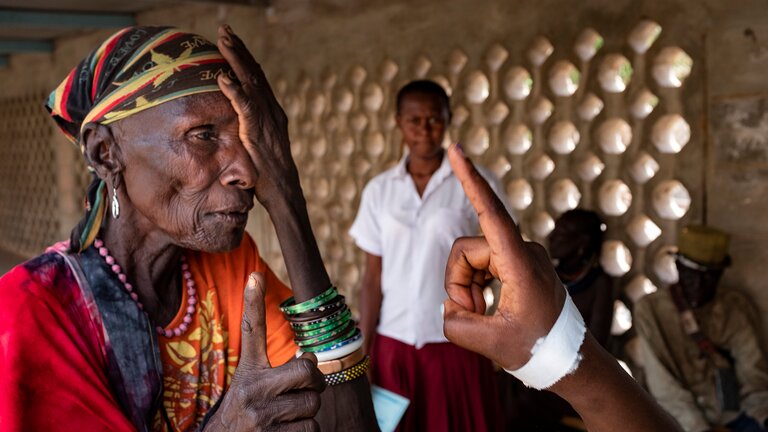Universally, at least 2.2 billion people suffer from different forms of vision impairment globally, according to the World Health Organization (WHO). At least half of these cases are preventable.
Vision impairment and blindness affect people of all ages but are more dominant in old age.
What is the difference between blindness and vision impairment?
Blindness is the state of complete loss of vision, due to either illnesses or genetic conditions. Vision impairment refers to the decrease of visual ability to a certain degree, resulting in problems that cannot be fixed by corrective methods such as glasses or corrective surgery. There are different categories of vision impairment and blindness.

Types of vision impairment
Distance vision impairment
People who have this type of vision impairment are long-sighted or hypermetropia. They can comfortably see objects at a distance but struggle to see those nearer.
Near vision impairment
Also termed as short-sightedness or myopia, this vision impairment makes it hard for a person to see far objects. Things appear blurry at a distance and clearer when closer to the eye.
Types of blindness
Total Blindness
Total blindness occurs when a person has a complete lack of vision. Total blindness can occur naturally, as some people are born without sight, or other factors cause it in some cases.
Legal Blindness
When a person is termed legally blind, they have a corrected vision of 20-200 in their best-seeing eye or less in one eye. This fact means that if an object is 200 meters away, you would have to stand at least 20 meters close to see it. Persons without disability can see the same object without moving closer.
Partial Blindness
A partially blind person has a specific limited vision. Partially blind persons may see blurry objects or have difficulties distinguishing the shapes of objects.
Leading causes of blindness and vision impairment
Blindness and vision problems can occur suddenly or over time due to various causes, from illnesses, genetic issues or accidents. Interestingly, when blindness occurs naturally, like in old age, there is no pain, at least most of the time.
There are several causes of blindness and visual impairment, however, cataracts and uncorrected refractive errors are the primary causes of sight loss. Age-related macular degeneration and glaucoma follow closely as the next most prevalent contributors to sight loss. Here we are going to look at six distinct causes.
-
1
Uncorrected Refracted Errors
Uncorrected Refractive Errors are one of the leading causes of blindness and occur when refractive errors are uncorrected on time. Refractive errors include:
- Myopia (near-sightedness)
- Hyperopia (far-sightedness)
- Astigmatism (distorted vision).
- Presbyopia (inability to focus up close and needs to hold reading materials farther from the eyes).
Luckily, optician-prescribed spectacles can help manage refractive errors.
-
2
Glaucoma
Glaucoma occurs when fluid builds up and damages the optic nerve connecting eye muscles to the brain. The nerve gets damaged by too much eye pressure. This condition affects mostly older persons from the age of sixty. Different types of glaucoma are detectable through a tonometry test that measures the eye's fluid pressure (intraocular pressure). Glaucoma is only treatable early as the damages can be irreversible.
-
3
Cataracts
A cataract is a clouding in the eye's lens, leading to decreased vision. Ageing, radiation exposure and diabetes in severe cases are some of the causes of cataracts. They occur when the lens of your eyes becomes less transparent, causing eyesight to be cloudy. The clouding is a result of protein building up in the lens. Symptoms may also include seeing faded colours, trouble with too much light and night blindness. It is easy to diagnose cataracts, and surgery is the most effective treatment for the condition. A clear artificial lens can also replace the cloudy eye lens in a safe, outpatient procedure.
-
4
Diabetic Retinopathy
Retinopathy is a diabetes complication that affects the eyes, and it occurs when poorly controlled blood sugar damages the tissue at the back of the eye. Symptoms include pain in the eyes, dark areas of vision or blurry vision that gets worse with time. If detected early through screening, the condition is preventable through diabetes management. Advanced cases are treatable with surgery or laser treatment.
-
5
Age-Related Macular Degeneration
Age-related macular degeneration is an eye disease that occurs when the small central portion of your retina, called the macula, wears down and loses function. Dry macular degeneration causes loss in the centre field of vision, while wet macular causes leaky blood vessels to grow under the retina. While it is painless, you may start to lose central vision. Age-related macular degeneration has no permanent cure because of the age factor. However, early detection can aid in managing the condition with simple adjustments like prescribed spectacles. A particular combination of vitamins and minerals can help slow down the progression of macular degeneration.
-
6
Trachoma

Trachoma is a bacterial infection caused by Bacterium Chlamydia Trachomatis and affects the eyes. According to WHO, Trachoma is the world’s leading cause of preventable blindness of infectious nature. The organization’s statistics indicate that the infection causes vision impairment and blindness in an estimated 1.9 million people globally. In addition, Trachoma is a public health issue in 44 countries worldwide.
The infection causes the inner surface of the eyelids to be rough. The roughening in the eyelids causes pain in the eye and a breakdown of the cornea's outer surface. If untreated, the pressure in the eye eventually leads to total blindness, which is irreversible according to WHO. Symptoms begin with mild itching and irritation in the eyes and eyelids, then progress to eye pain and blurry vision. The early stages of Trachoma are treatable with antibiotics, while advanced stages are treatable with surgery. Proper sanitation and clean water play a vital role in preventing Trachoma infections.
Remedies for Blindness and Vision Impairment
Prevention
The WHO estimates that at least half of all vision impairment cases are preventable. Due to the sensitive nature of the eyes, early detection is essential. The essentiality, therefore, calls for intensive efforts to teach people about good eye health so that they can identify vision defects early on and seek treatment before it is too late.
Prompt Treatment
Visual impairments tend to progress fast due to the sensitive nature of the eye. Therefore, it is necessary to ensure that affected persons receive the required care in good time.
Vision Rehabilitation
Rehabilitation is helpful for people with irreversible visual impairment such as advanced trachoma and age-related macular degeneration. Vision rehabilitation includes using assistive devices such as braille and walking canes and learning to carry out other daily activities independently. Such interventions will help improve the functioning of such persons.
Implementing the Recommendations of the World Report on Vision 2019
Adopted during the 70th World Health Assembly in 2019, the World Report on Vision highlights the extent of visual impairments globally and offers recommendations to address the same.
The main recommendation of the report is for states to adopt integrated people-centred eye care (IPEC) in addressing visual impairments. IPEC provides a series of health interventions aimed at addressing eye conditions holistically. The Report offers four strategies:
1. Empowering and engaging people and communities
This strategy calls on governments to reform health systems to improve the healthcare experience. It also emphasizes the need for health literacy to facilitate timely interventions. An example of people and community engagement is the use of Ivermectin to prevent onchocerciasis. Onchocerciasis is an eye condition transmitted by blackflies and can cause visual impairment and, at its worst, blindness.
2. Reorienting the model of care
Reorienting the model of care ensures that governments design and provide efficient and effective healthcare services through innovative models of care. Such models should prioritize primary and community care services and the co-production of health.
3. Coordinating services within and across sectors
This strategy focuses on enhancing care delivery by aligning and harmonizing processes and information. It calls for the coordination of individuals, health programs and providers, and coordination across sectors.
4. Creating an enabling environment
The previous three IPEC strategies will not function without an enabling environment. According to WHO, an enabling environment is achievable through “six building blocks of a health system.” They include delivering eye care services, leadership and governance, and information. The others are the health workforce, health financing, and medicines and technologies (including assistive products).
The implementation of IPEC will ensure that states achieve target 3.8 of the Sustainable Development Goals (SDGs) on universal health coverage.
